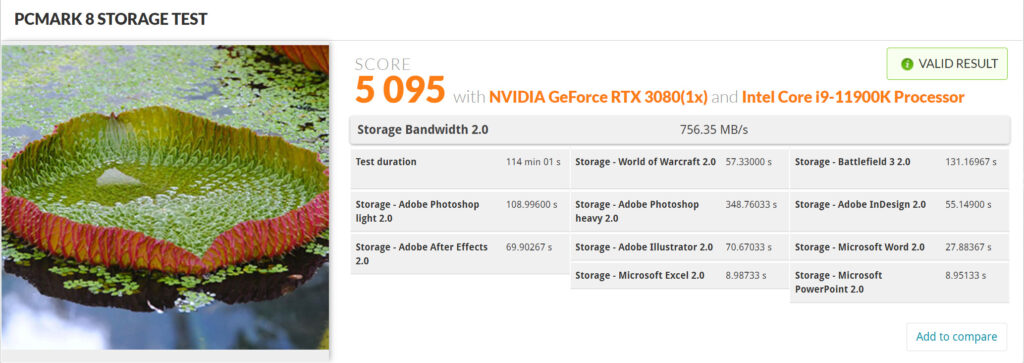The SSD Review uses PCMark 8’s Storage test suite to create testing scenarios that might be used in the typical user experience. With 10 traces recorded from Adobe Creative Suite, Microsoft Office and a selection of popular games, it covers some of the most popular light to heavy workloads. Unlike synthetic storage tests, the PCMark 8 Storage benchmark highlights real-world performance differences between storage devices. After an initial break-in cycle and three rounds of the testing, we are given a file score and bandwidth amount. The higher the score/bandwidth, the better the drive performs.
PCMARK 10 FULL SYSTEM STORAGE BENCHMARK
PCMark 10 Storage Benchmarks produce an overall score as a measure of drive performance. Comparing devices is as simple as comparing scores. The tests also measure and report the bandwidth and average access time performance for the drive. Each test uses traces recorded while performing real-world tasks such as booting Windows 10, starting applications such as Adobe Photoshop and Illustrator, working with applications such as Microsoft Excel and PowerPoint, and copying several large files and many small files.
In testing in both PCMark 8 and 10, we observed that performance results were consistently better and comparison charts of our storage would take some time. We thought it beneficial to still post these results as they are very good.
PCMARK 8/10 GEN 4 SSD COMPARISON CHART – INTEL TEST BENCH
We are just starting to put comparison charts together for the new Intel Gen 4 Test Bench with respect to PCMark 8 and 10. A bit surprising perhaps is that the Mushkin Gamma provided the best results of the three complete tests conducted.
REAL WORLD FILE TRANSFER COMPARISON
We have put the Mushkin Gamma Gen 4 NVMe SSD beside a few other Gen4 SSDs that we have just retested on the Intel Z590 Gen 4 Bench. Once again, we found these significantly higher than testing with the AMD Test Bench so didn’t want to mix and match results.
These SSDs fall in line with where we might expect and, for the most part, our biggest difference from same in the AMD Gen 4 Test Bench comes with respect to the Photo and Music transfer speeds.
REVIEW ANALYSIS AND FINAL THOUGHTS
The Mushkin Enhanced Gen 4 Gamma NVMe SSD is yet another great example of the SSDs being put out today that have a full feature set. Let’s give just a little credit here to Phison for their SSD controller design, a company that most recently saw their SSDs reach Mars. For the most part, many of these can be considered upper tier SSDs and will command a price bump for much more than their ability to provide 7GB/s plus throughput data transfer alone. As far as a feature set goes, Mushkin MEDS ( Mushkin Enhanced Data Protection Suite) includes such things as 4th Gen LDPCC ECC, end-to-end data protection, SmartECC, AES 128/256-bit hardware encryption and much more.
As with most other current gen SSDs , the 5-year limited warranty is standard and, if you think about it, is actually a rarity considering so few things ever have 5-year warranties these days. Pricing. MSRP is listed at $259 (1TB) and $499 (2TB) and we are starting to see that price in retail channels. We might suggest this price needs to come down when you have competition such as the Samsung 980 Pro and WD_Black with similar performance, stellar reputations and priced just a bit cheaper than the Gamma. All in all…great SSD and definitely recommended.
Check Mushkin Gamma Pricing at Amazon
 The SSD Review The Worlds Dedicated SSD Education and Review Resource |
The SSD Review The Worlds Dedicated SSD Education and Review Resource | 


How long can I write at the write speed of 6.8GB/s? Until the SSD is fully written or just a few seconds ?
I have this feeling that you already know the answer to that and it would be one heck of a challenge actually ever achieving a steady 6.8GB/s transfer write speed. This is the flash industry theme, however, where the SSD is advertised at its maximum potential and not steady state or speeds that will occur over linger file transfers. I would guess that this is because those speeds are so greatly affected by the data sample they are moving, whether it be media or much smaller OS files for instance. We could relate this to how vehicles advertise their high mileage couldn’t we? Thanks for jumping in!